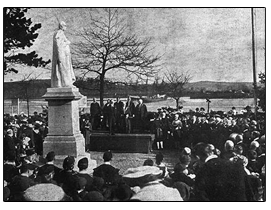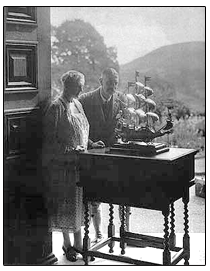
In 1854 Charles Kingsley came to Bideford, hired a house at the end of the Strand (now Stella Maris Court) and wrote his best-seller Westward Ho! So successful was it that readers came to Bideford as tourists to see the real sites used by Kingsley for his story’s setting – thus starting the town’s tourist industry. In March 1903 the Mayor E Tattersill set up the Kingsley Memorial Committee which decided on ‘something to look at’ i.e. a statue rather than a building named after the author. By June funds were coming in and the Mayor suggested placing the statue where today’s library now stands – even though one councillor suggested it might look like an extension of St.Mary’s graveyard! By May 1904 some £400 had been collected and the Committee were inspecting models of the proposed statue and proposing to site it at the bottom of High Street on the Quay facing up the hill. In August of that year Joseph Whitehead’s design was accepted – this being an 8’ high Sicilian marble statue with a 9’ high Portland Stone plinth at a cost of £530. Work pressed ahead and in February 1906 Mayor Tattersill (by then in the third year of his Mayoralty) and Lord Clinton unveiled the completed statue at the site where it still stands today – a proud monument to a famous Victorian.

October 1881 the Port of Bideford was abolished by Parliament. This didn’t mean that the harbour was closed but rather all the status associated with being an official port disappeared. This long rankled with the council and in August 1928 following pressure from councillors Huxham and Goaman plus the MP Sir Basil Peto and Sir William Reardon Smith (an Appledore born shipowner) the designation was returned to Bideford. The four had journeyed to London to have a meeting with Winston Churchill, then in the Treasury, and the fact that Sir William had registered his 36 ships at Bideford carried a lot of weight – especially as they represented the largest registered tonnage of any port in Devon.
Needless to say there were huge celebrations in the town when the honour was reinstated and to mark the restitution Sir Basil presented the town with the marvellous silver ship model that still takes pride of place during ceremonial council events. It dates from around 1750 and represents an Elizabethan vessel manned with ‘silver sailors’ and sits on 4 silver dolphins who themselves sit on 4 wheels. Intriguingly at the presentation ceremony the Mayor carried the ‘small silver oar’ which was the insignia of the Lord of the Manor – which has now gone missing. If anyone knows of its whereabouts please do contact the Town Clerk.
In 1879 four seats on the town council became vacant and six candidates stood, being divided between pro-drinkers, led by Mr Ascott of the New Inn, and teetotallers under Mr Restarick a local shipbuilder. Voters came to the town hall to both vote and hear the result announced – Ascott 320, Restarick 258. Amidst ‘hooting and yelling, cheers and hisses.’ Restarick declared ‘that his head was clear, as they would always find that of a teetotaller’ – which was met with cries of ‘Shut your mouth’. He then said he would reduce the rates by ‘doing away with the public houses’ which caused ‘indescribable confusion’ and cries of ‘kick him out’. Fighting then broke out between some of the other candidates and onlookers – although ‘the room was too densely crowded to all of the fight becoming general.’ Eventually the town hall was cleared by the police and ‘so ended one of the most tumultuous meetings that has taken place in Bideford even so far back as the memory of the oldest inhabitant reached.’ As is clear our ancestors took their politics seriously.
The Town Council purchased the right to the Pannier Market in 1881 and immediately decided to rebuild the old ramshackle premises. After some major squabbles over both the plans and where to move the traders whilst reconstruction was going on the new building was finally opened in April 1884 at a cost of £2956.6.0. Contemporary descriptions fit almost exactly what is there today – with one major exception. The coverage of the new building in the Journal notes ‘In the centre is a stone fountain.’ This had been suggested and paid for by Alderman W L Vellacott a long time councillor. When this disappeared is uncertain but does anyone have a photograph of it – and should the council reinstate what today would doubtless be called ‘a water feature’ in the market hall?
There are few surviving links with Bideford’s Elizabethan past – but there is one that is a mystery. In 1894 Thomas Tedrake, proprietor of the Bideford based Western Express newspaper, published his Illustrated Guide to Bideford and North Devon in which he wrote of the Castle Inn in Allhalland Street (the building next to the Bridge Buildings) being part of the residence of Sir Richard Grenville – once the town’s Lord of the Manor and the man who master-minded the first permanent English settlement in North America. There is no proof that this was his house but Tedrake does note that a picture over the bar of the Inn showed ‘the Fort of Virginia and two ships with the Grenville flag passing under its guns.’ Tedrake says this was painted on Grenville’s orders but by 1894, not surprisingly, it was ‘somewhat blurred and obscured by dirt and varnish.’ That the picture had been accurate had been confirmed in 1892 when the Reverend Dr Hale of Boston, USA inspected the picture. Three years after Tedrake published his book a couple visited Bideford and recorded seeing the same painting noting that they were told that ‘persons had come from America purposely to see it, and they [the publican] had been offered thousands for it, but of course it could not be sold as it is painted on the wall.’ Apart from these two references the painting seems to have disappeared – but to where? If anyone knows the council would love to hear from them.
